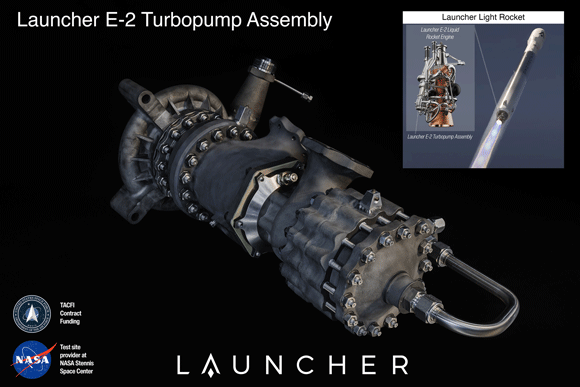Launcher successfully tests turbopump on its additively manufactured E-2 rocket engine
October 19, 2022

Launcher, headquartered in Hawthorne, California, USA, reports that the latest test on its additively manufactured E-2 rocket engine for the US Space Force has been successful. The company states that the test demonstrated the highest performance of a kerosene rocket engine turbopump ever manufactured in the US. This follows Launcher’s successful test fire earlier this year.
The E-2 is a closed-cycle, additively manufactured, high-performance liquid rocket engine in development to power the Launcher Light launch vehicle to orbit with a single engine in its first stage. The successful E-2 turbopump tests took place in late September 2022 at NASA Stennis Space Center. The E-2 test team achieved or exceeded all power, input and output pressure, efficiency, and vibration goals over the course of eleven tests, including long duration, cavitation, and boosted flow.
The pump assembly used Kerosene (RP-1) and liquid oxygen (LOX) as working fluids. The power for the turbine in this test campaign was high-pressure gaseous nitrogen. This test was approved by the U.S. Space Force as part of Launcher’s Tactical Funding Increase (TACFI) contract.
Launcher reports that the E-2 turbopump assembly offers the following benefits:
- Additively manufactured at Launcher’s facility: Controls the cost and lead time of turbine, housings, rotating inducers, and impellers
- High pressure: With 330 bar (4,786 psi) of liquid oxygen and fuel output pressure achieved enabling E-2’s high-pressure oxidiser-rich staged combustion engine cycle
- Lightweight and compact: the single-shaft turbopump includes a turbine, two fuel pumps (RP-1) and a liquid oxygen pump (LOX)
- Streamlined turbine design: Novel design achieves 72% efficiency – surpassing the typical 60% efficiency found on other rocket engine turbopump turbines
- High efficiency pumps: This allows E-2 to keep its engine pre-burner at low temperature (200ºC), thereby lowering the cost of materials and reducing the risk of oxygen flammability, a key challenge in developing oxidiser-rich staged combustion engines. It also provides margin to achieve designed engine thrust levels
- Simplified: The turbopump design eliminates the need for a kicker turbine or liquid oxygen booster pump, despite a relatively low input pressure from the rocket propellant tanks
Under the U.S. Space Force’s TACFI contract, Launcher’s next step in E-2 engine development will be pre-burner component testing which is scheduled to begin in November 2022, followed by a long-duration test of the integrated E-2 engine (thrust chamber and turbopump in a closed-cycle) in Q1 2023.
“We would like to thank the US Space Force and NASA for their support of innovation and for making Launcher’s latest high-performance records possible,” commented Launcher CEO Max Haot. “By achieving our turbopump milestone, Launcher is one step closer to realising its mission to expand space access.”
















